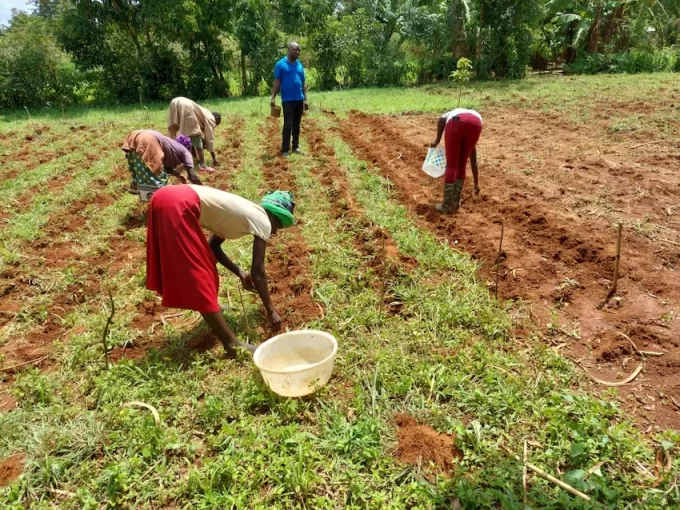Shunned by the current generation, cassava is set for a big comeback thanks to the introduction of a European Union Ksh773.5 billion project to be initiated in cassava growing counties.
In his hey days, William Oduor would uproot a cassava plant, peel the roots and assuage his hunger as he and siblings continued to weed.
Today, the 86-year-old resident of West Ugenya location, Siaya County cannot dare touch the root crop that has in the recent past been classified among the orphaned crops in the country.
Oduor remembers an incident close to decade ago, that nearly send him to the grave. After spending some hours weeding he found a bunch of cassava that had been harvested by his wife. Struggling to fight pangs of hunger, he felt a small root was all he needed to quell the demands of the stomach as he waited for lunch.
Quickly, he picked a knife and started peeling the root, despite a warning from his wife that the cassava species was not meant to be consumed raw, and had to undergo several stages of preparation before being ground into flour to prepare a meal.
“I did not heed the warning. I dismissed her since I knew, from childhood, that chewing raw cassava was a past time we all enjoyed,” recalls Oduor.
What followed, he says, remains perched in his mind to date. He suffered severe stomach ache, accompanied by acute diarrhea and vomiting. This, he adds, has made him detest cassava to date. Were it not for quick action by his wife, he would not be alive to narrate this story.
Oduor is not alone. Most people in areas that were initially cassava growing areas no longer want to be associated with the crop that was used to cushion communities against hunger during dry spells. More people have since the late 1990s suffered after eating raw cassava, with some succumbing.
It is during this period that the traditional cassava varieties that could be munched without a second became extinct, after a virulent form of cassava mosaic disease invaded the crop.
This led to the introduction of new disease resistant varieties that is mostly grown in parts of Western Kenya that is consumed by 60% of the national population.
The future of the crop, however, seems bright with the introduction of a five year European Union funded project that seeks to create jobs, increase food and nutrition security, as well as the quality, productivity and its marketability both locally and abroad.
The project dubbed ‘Strengthening the competitiveness of the cassava value chain in Kenya’ targets to benefit 28,000 smallholder farming households.
It is expected that through the project, over 140,000 people, 60% of them women will acquire clean and quality planting materials and will be assisted to improve productivity and marketability of the food crop through a grant of over Sh 700 million.
Speaking recently during the launch of the project, EU Head of Rural Development and Food Security, Klaus Gautsch said as a drought resistant crop, the cassava project will “help to address the need for sustainable food and nutrition security, strengthen resilience to climate change, create job opportunities and increase incomes for small holder farmers.”
Gautsch said a grant of up to 6.5 million Euros (Sh 773.5 billion) will be used to create 5,600 new jobs and increase access to credit to at least 50% of farmers and businesses that are active in the cassava value chain, in the target counties of Kisumu, Homabay, Migori, Siaya, Busia, Kitui and Kilifi.
He said the EU has seen a real opportunity for cassava farmers, not only because they will increase production for household cooking, but because the project will help to meet the growing demand for cassava products in the industrial, food, beverage, livestock feed, and textile sectors.
He said the programme seeks to increase average production for subsistence farmers from 2.5 metric tonnes per acre to 7 metric tonnes, and for pre-commercial farmers from 5 metric tonnes to 10 metric tonnes per acre.
Agriculture Cabinet Secretary, Willy Bett, who spoke during the launch, said the project was in line with the agricultural sector goal of achieving an average growth rate of seven per cent per year through increased production levels.
- Nigeria to set up cassava bread development fund
- Food shortage looms in Kenya
- Food drives up inflation in Eastern Africa
“This programme will go a long way in supporting our mission to ensure an innovative, commercially-oriented and modern agriculture by 2020 as stipulated in the Agricultural Sector Development Strategy,” Bett said.
The cassava value chain project is being implemented through Self Help Africa (SHA) in partnership with Rafiki Microfinance Bank, Rheal Solutions, Ugunja Community Resource Centre and Ustadi Foundation and TruTrade in the target counties of Kisumu, Homabay, Migori, Siaya, Busia Kitui and Kilifi.
Addressing a stakeholder engagement forum in Ugunja, Siaya County, the programme manager of the Ugunja Community Resource Centre (UCRC), which is one of the implementing Non Governmental Organisations, Charles Ogada lamented that Cassava, together with other traditional crops such as Millet, Sorghum and sweet potatoes had long been neglected despite their nutritional value.
Ogada however said that the rural communities in the targeted areas were set to benefit from the value chain since the project will engage in market oriented agriculture, where they will be linked to buyers.
He said they will help the farmers acquire disease free, high yielding seed cuttings from the over 300 farmers, who will be contracted to supply the same from their cuttings.
Ogada called on Kenyans to embrace Cassava production, adding that apart from being consumed as food, the same was also a much sought after raw material for production of industrial raw materials such as starch.
He said other than increasing the average production levels, the project will also support increased access to markets by promoting linkages with medium, small and micro-enterprises working in upstream value chains.
A woody shrub native to South America cassava is extensively cultivated as an annual crop in tropical and sub tropical regions, and in some quarters it is described as a poor man’s crop.
Nutritionists say it is a major source of calories and carbohydrates. A 100 gramme service of boiled cassava root contains 112 calories, compared to the equal serving of sweet potatoes which contains 76.
The roots also provide fibre, Thiamine, phosphorous calcium, riboflavin iron and vitamin C among others, helps to reduce inflammation and promotes digestive health, hence reduces the risk of obesity and Type 2 diabetes.
However, despite its benefits, a meal of cassava can be fatal if it is not prepared well. Raw cassava contains chemicals known as Cyanogenic glycosides, which can release Cyanide in the body when consumed.













Leave a comment